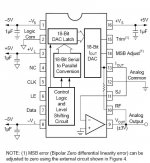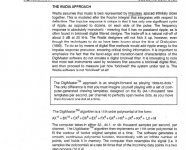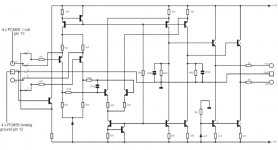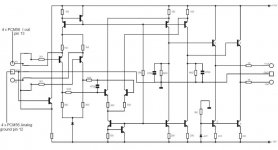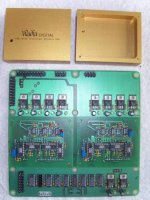Can anyone explain how much output current there is available on pin 13 (I out) of the PCM56P and PCM61P as it states in the data sheet (Current: Output Range ±30% ±1 mA)????? What does that mean.
And I have 4x PCM56P K's per channel all pin 13 paralleled so what will mine be mA wise?
And I have 4x PCM56P K's per channel all pin 13 paralleled so what will mine be mA wise?
Attachments
...doesn't it just mean that the analog output (as a current) will be sinking 1mA when on the positive peaks, and sourcing 1mA on the negative peaks (or is sinking/sourcing the other way around?)
This is in the "typical" column for the output current,
then isn't the +/-30% just the tolerance, like it can be anything between the "smallest range" -0.7mA to +0.7mA
and the "largest range" -1.3mA to +1.3mA.
(sorry if this is a naive answer, maybe you're looking for something deeper... )
)
_
This is in the "typical" column for the output current,
then isn't the +/-30% just the tolerance, like it can be anything between the "smallest range" -0.7mA to +0.7mA
and the "largest range" -1.3mA to +1.3mA.
(sorry if this is a naive answer, maybe you're looking for something deeper...
 )
)_
Anything is good, as no one is giving anything else.
Is it safe to assume then because I have 4 x paralleled outputs from 4 dacs per channel I should get 4 times the mA ?
Remember these 4 dacs (PCM56P) per channel are not paralleled (stacked) up like other are doing with other dacs, only their outputs are paralleled.
Here is a link to the data sheet
http://www.datasheetcatalog.org/datasheet/BurrBrown/mXutrrt.pdf
And a link to my dac
http://www.diyaudio.com/forums/showthread.php?s=&threadid=131856
Cheers George
Is it safe to assume then because I have 4 x paralleled outputs from 4 dacs per channel I should get 4 times the mA ?
Remember these 4 dacs (PCM56P) per channel are not paralleled (stacked) up like other are doing with other dacs, only their outputs are paralleled.
Here is a link to the data sheet
http://www.datasheetcatalog.org/datasheet/BurrBrown/mXutrrt.pdf
And a link to my dac
http://www.diyaudio.com/forums/showthread.php?s=&threadid=131856
Cheers George
n DACs have n mA.
There is +/-30% tolerance which can in worst case result in a few dB difference in output level between left and right .
You can match chips of course.
IIRC this DAC uses additional hardware os, the chips are not just parallel.
Like in the DAC of ECdesigns but with os filter-IC.
There is +/-30% tolerance which can in worst case result in a few dB difference in output level between left and right .
You can match chips of course.
IIRC this DAC uses additional hardware os, the chips are not just parallel.
Like in the DAC of ECdesigns but with os filter-IC.
Bernhard said:
IIRC this DAC uses additional hardware os, the chips are not just parallel.
Like in the DAC of ECdesigns but with os filter-IC.
Charles Hansen Quote
Right Wadia used "64X 18-Bit Transversal Multiport DAC". The first thing you should know is that no audio DAC would operate at 64x in those days. So what they did was make a high frequency clock and take 4 DACs per channel in a "transversal" mode. The digital filter could only do 16x. Each DAC got a word clock signal that was staggered by 1/4 of the word clock rate. Then the output of the 4 DACs were recombined to make the final audio output. (I could be off by a factor of two here. Maybe the filter did 32x and there were only two "transversal" DACs.)
Over my head, can someone explain in laymans terms?
Cheers George
Wadia used "64X 18-Bit Transversal Multiport DAC". The first thing you should know is that no audio DAC would operate at 64x in those days. So what they did was make a high frequency clock and take 4 DACs per channel in a "transversal" mode. The digital filter could only do 16x. Each DAC got a word clock signal that was staggered by 1/4 of the word clock rate. Then the output of the 4 DACs were recombined to make the final audio output.
AFAIK, it uses four DACs with each DAC getting every fourth sample only, such that:
Sample one to DAC A, sample two to DAC B, 3 to C, 4 to D, 5 to A, 6 to B and so on.
It means that each DAC is clocked at 1/4 of the frequency of the stream coming out of the digital filter, or whatever does the oversampling. To get 64X OS, each of the four DACs would be running as though OSed to 16X. I think the PCM56 is only good for 4X, so you wouldn't be able to get to more than 16X overall using this configuration with this chip.
Sounds like a good idea, and shouldn't be too hard to do with a CPLD.
Nice choice of chip though, the PCM56. I have heard that it is one of the best for NOS applications, I must try it sometime.
Anton
georgehifi said:
Over my head, can someone explain in laymans terms?
Above my knwoledge as well, but I have the feeling that it is related with some discussions on "multiple more-or-less-parallel DACs" for example here:
http://www.diyaudio.com/forums/showthread.php?postid=980307#post980307
_
See same thread
http://www.diyaudio.com/forums/showthread.php?s=&threadid=79452&perpage=25&pagenumber=1
Post 9 & post 15
Andy
http://www.diyaudio.com/forums/showthread.php?s=&threadid=79452&perpage=25&pagenumber=1
Post 9 & post 15
Andy
This is Wadia F. Moses take on it Anton, is it the same as you said? Also do you think it is safe to assume that the current output from the pin 13 I out will be 4 x as strong? as my Transimpedance Amp that I'll be using with it's output stage will have a gain of 2. and I would like to have 3v or more out.
Cheers George
Cheers George
Attachments
This is how I think to do this, I hope I get over 2v outs, the circuit has 2 x gain, will this circuit tax the 4 x PCM56p outputs too much as I was told it was less than 10ohm input impedance, all comments invited, I won't attack this, until I'm sure, as it it one expensive piece of gear.
Also I don't know if to bridge pin 4 for common grounding of both input and output?
Cheers George
Also I don't know if to bridge pin 4 for common grounding of both input and output?
Cheers George
Attachments
...I'd have many good reasons to stay silent (not much knowledge, not much time to acquire more right now, so not really "a peer", etc.) but I won't 
Whether it's a useful piece of info or not:
The Cambridge CD2 and CD3 architecture, that also uses that principle of the 4x over-oversampling obtained with shift registers (after another 4x from a normal filter, an SAA7220) brings together the outputs of four DACs (per channel) *after* (op-amps based) I/V conversion; just through a resistor (four actually) into the same point.
ecdesign says in his description (in the post #15 indicated above): "2 pair of DAC outputs in parallel, then these two are fed into a differential amplifier after I/V conversion"
which seems to suggest some current summing for two DACs, then I/V, then into a differential amplifier (unlike Cambridge).
Is it all just currents summing à-la-Kirchhoff?
(edit: no, the diff-amp isn't, I know...)
_

Whether it's a useful piece of info or not:
The Cambridge CD2 and CD3 architecture, that also uses that principle of the 4x over-oversampling obtained with shift registers (after another 4x from a normal filter, an SAA7220) brings together the outputs of four DACs (per channel) *after* (op-amps based) I/V conversion; just through a resistor (four actually) into the same point.
ecdesign says in his description (in the post #15 indicated above): "2 pair of DAC outputs in parallel, then these two are fed into a differential amplifier after I/V conversion"
which seems to suggest some current summing for two DACs, then I/V, then into a differential amplifier (unlike Cambridge).
Is it all just currents summing à-la-Kirchhoff?
(edit: no, the diff-amp isn't, I know...)
_
Bernhard said:It should be 4 mA.
From Vout and Ri/v you could calculate Iout.
Why not leave the poor DAC in peace and build something ?
Bernhard your suggestion to leave the poor dac in peace sucked!
Ok the surgery has been done, and now the 4 X PCM56P K's each channel are driving the circuit below from their current outputs.
And the level is about 20% greater than the standard I/V (OPA606) and Sledgehammer (HA-5002.5) output board had.
The sound is much much better top to bottom, the current output of the dacs have a proper Transimpedance discrete direct coupled I/V amp to work into, and the output stage is also now discrete class A direct coupled. Worth ever cent of the time and effort.
Benhard seeing this Wadia unit is well over 10 years old closer to 20, the 4 PCM56 per channel that have 1 muliturn pot each channel to do the MSB adjustment, would they drift after all this time?
If so what's the simplest way of re-adjusting them, I have never done it and don't know what to look for. I have a good fast cro and a Denon test disc that has 100hz 1khz 10khz sine waves at -60db and also a track that has infinity zero (silence)
I was thinking maybe the voltage output of the 4 x PCM56's which the data sheet says is 3v out@2mA and .1ohm output impedance could be utilized for MSB adjusting? (to get the lowest noise floor). Have you any suggestions?
Cheers George
Attachments
In the datas BB said that for passive IV they used Riv=200ohms
I put the 100 and amlify additionaly with transistor stage (like hafler preamp darlington cir.)
with very good results
the chip stays just warm not hot,
that was just the tryout of dac chip
but I was stouned, realy...
cheers
I put the 100 and amlify additionaly with transistor stage (like hafler preamp darlington cir.)
with very good results
the chip stays just warm not hot,
that was just the tryout of dac chip
but I was stouned, realy...
cheers
I must see how hot mine are running as all 4 per channel are pushing into that active I/V stage which I was told by it's designer was close to zero ohms input impedance, sure does sound good.
I'll wait to check the heat as they are covered by the gold boxes, and may be at the same time Bernhard or someone can give me some instructions on whether after all these years the MSB may need adjusting again.
Zoran have you had much to do with adjusting the MSB?
Cheers George
I'll wait to check the heat as they are covered by the gold boxes, and may be at the same time Bernhard or someone can give me some instructions on whether after all these years the MSB may need adjusting again.
Zoran have you had much to do with adjusting the MSB?
Cheers George
Attachments
George,
1 kHz -60dB with dither and use a preamp
Watch harmonics with spectrum analyzer / 8x averaging
Or amplify and listen with headphones.
Zoran,
PCM56 is happy with anything up to 500 ohm per chip.
You will only loose sound quality with 100 ohm and unnecessary preamp.
Heat is not an issue and depends only on supply voltages.
See datasheet.
1 kHz -60dB with dither and use a preamp
Watch harmonics with spectrum analyzer / 8x averaging
Or amplify and listen with headphones.
Zoran,
PCM56 is happy with anything up to 500 ohm per chip.
You will only loose sound quality with 100 ohm and unnecessary preamp.
Heat is not an issue and depends only on supply voltages.
See datasheet.
Bernhard said:George,
1 kHz -60dB with dither and use a preamp
Watch harmonics with spectrum analyzer / 8x averaging
Or amplify and listen with headphones.
Zoran,
PCM56 is happy with anything up to 500 ohm per chip
Thanks Bernhard, pity it can't be done using a scope, then you have great experience with this. Being one of your favorite dac's, do you think after all this time they could have drifted? or do they stay stable over time especially when a quality mutiturn pot was used for MSB setup? As I believe that Wadia would have got it spot on with their $ setup test equipment.
BTW that Sony BU-1E laser I got off you for that 30kg DX-G10 Onkyo is still going strong.
Cheers George
The PSU's are all good, so the MSB should be given a tweak, I'll have to use headphones as i don't have an Distorion Analyser, I just hope I can hear it, as you know the Wadia had a very gentle hf filter so the noise I should hear maybe obscured by the lack of HF filtering?
Cheers George
Cheers George
- Status
- This old topic is closed. If you want to reopen this topic, contact a moderator using the "Report Post" button.
- Home
- Source & Line
- Digital Line Level
- Output Current from PCM56P K?
